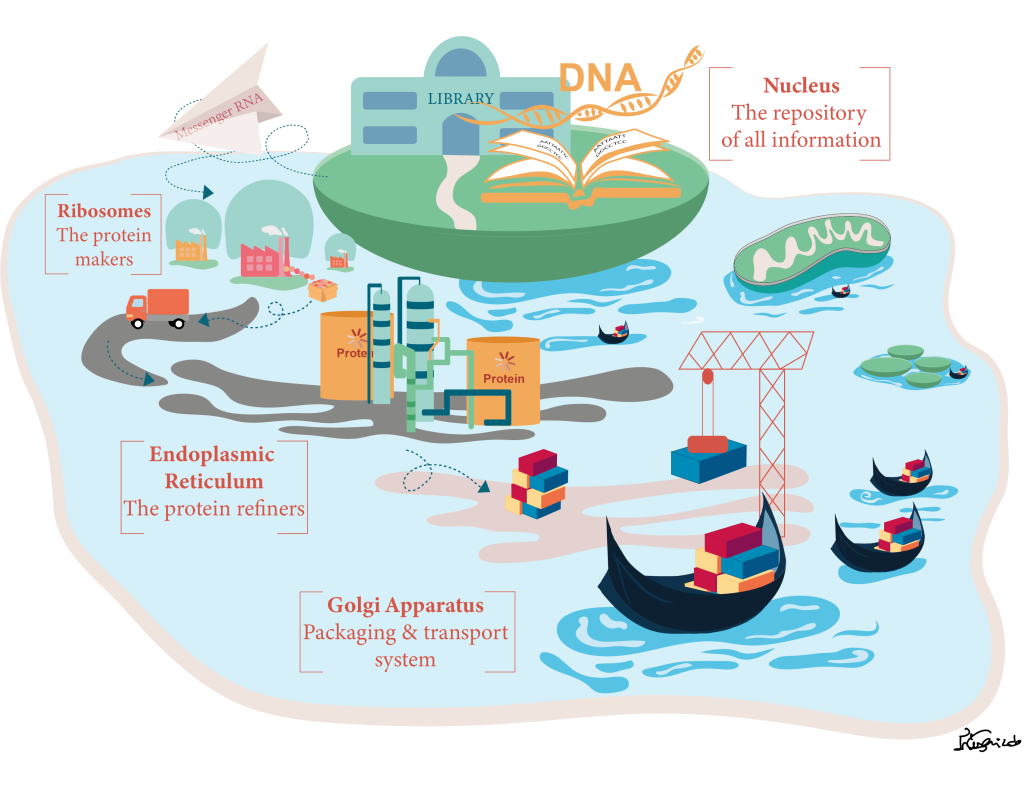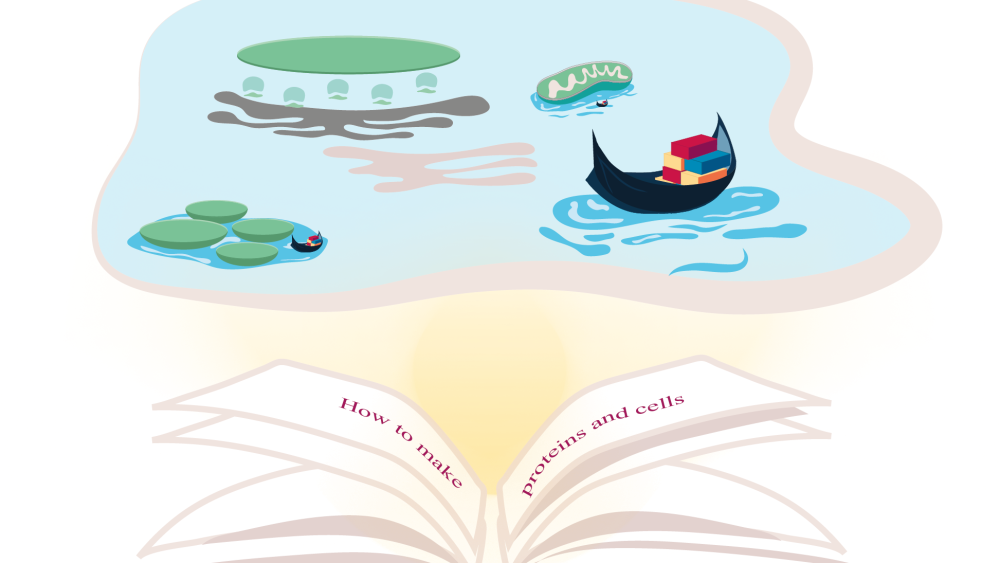Dear reader, I will ask you right now to imagine the voice of your favorite teacher saying:
A cell is the smallest unit of life.
Also, since you already tuned their voice in your head, keep going:
Drugs are bad.
Stay in school.
Donate a lot of money to the Science as We Know It team so that they can go on vacation to Hawaii.
Indeed, your teacher was right. Every living thing is composed of cells. And inside those cells, there are other structures that do their own things – the organelles.
Perhaps the most famous organelle, the mitochondria, is usually known for being “the powerhouse of the cell”.
But… what other interesting comparisons can we make with these organelles? If we imagine a cell as a city, what are the infrastructures that allow this urban paradise of life to thrive like a metropolis?
Today, let’s focus on the “industrial process” occurring inside the cells. A very well-organized assembly line that starts in the “books” of DNA and ends on the packaging and transportation of the vital molecules for the cell – the proteins.
Nucleus – The Library
Ah, the most noble place in the cell… The nucleus is where the DNA – that long molecule (both in name and in size) – is stored.
DNA is like a textbook, composed of long lines of smaller molecules. These molecules are the alphabet to “write” the instructions to produce all proteins in the cell. And the smart thing about life is that every cell* contains, in its nucleus, all the DNA containing the instructions to assemble all proteins. The information is always there, in this repository of information.
And yes, if you are wondering, you must always be quiet in the nucleus. Come on, people are trying to read some DNA there. Be respectful!
*Apart from reproductive cells. But let’s ignore those for now. It’s too early to talk about how babies are made.
Ribosomes – The Factories
If the nucleus is the quiet place where the information is stored, the ribosomes are the workplace where hardworking laborers get their hands dirty to make proteins. The information comes from the nucleus, but not in the form of DNA. Nah nah nah, the librarians do not let you bring the DNA books directly. Do you want some information, honey? Then copy it into a new piece of paper.
And that’s exactly what the messenger RNA is – a draft copy from DNA which is brought to the ribosomes where it is translated into proteins.
24 hours a day, 7 days a week, nightshifts… Ribosome production can’t stop, or else… Well, you die. So, let’s really hope ribosomes never think about going on strike.
Endoplasmic Reticulum – The Refinery
You probably can tell that protein production is a big thing for the cell, right? It’s what keeps it together and functioning properly. Therefore, it is also a rather complex process. And, sometimes, the proteins coming straight from the ribosomes are still not in their final form. So, in the endoplasmic reticulum, which is right beside the ribosomes, some freshly produced proteins are then further… Let’s say… Refined, processed. They are folded in a more sophisticated way and made so their function is best once they go out of the process.
Golgi Apparatus – The Transportation Terminal
This is where the whole chain of protein production comes to an end. After being manufactured in the ribosomes and refined in the endoplasmic reticulum, proteins are brought to the Golgi Apparatus where they can be ultimately packaged for transport and delivery throughout (or even out of) the cell.
We can call it the transportation company of the cell.
CellEx.
DHCell.
UPS(ell).
All right, I stopped now.

Illustration by Inês Caiado


Mail Tm
very informative articles or reviews at this time.
Rui Caiado
Ah! You almost tricked me with the Hawai part, was already preparing a donation of 1 Million “ATP” ( I heard or read somewhere ATP is like the “currency” of the human body, so… IT guy trying to make a science joke, sorry 😂) .
Question: When you say RNA is the draft copy that afterwards is translated, does it mean you copy all the chapters of the DNA book? Or just the chapter you need for a specific protein production?
Great post, keep up the good work 😉
Luís Oliveira
Oh, our ATP terminal is unfortunately out of service… But we gladly accept PayPal, bank transfer, crypto (since you’re in IT). Or even good old cash. 💶💶💶 You just need an envelope and our address, which we will be very happy to share with you via private message. (For legal reasons I must state here that this is a joke.)
About your question: the messenger RNA “draft” is usually a copy of just a specific “chapter”, or a specific “paragraph” of the DNA, if you will. The part that corresponds to a specific protein (a gene). Then, for different proteins you have different messenger RNAs.
Thank you for your question and feedback! 😀